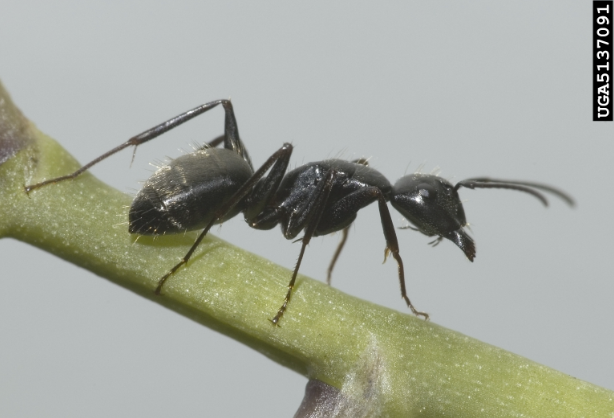Carpenter Ants
ENTFACT-603: Carpenter Ants | Download PDF | En Español
by Allison Lopina, Graduate Research Assistant & Zach DEvries, extension specialist
University of Kentucky College of Agriculture
Susan Ellis, Bugwood.org
Fast Facts
-
Carpenter ants are large, black ants that are commonly found in wood structures.
-
Carpenter ants tunnel through moist wood, but can also inhabit dry wood. Their ability to cause physical damage to wooden structures is variable; given enough time their damage can be significant to the integrity of the structure.
-
Carpenter ants may be a nuisance to humans, but they do not pose any human health threats. They will only bite if their nest is disturbed, or if picked up directly.
-
Infestations are most commonly controlled by pest control operators who are trained in using the appropriate tools and insecticides to get rid of the carpenter ants.
Introduction
Carpenter ants are a common indoor insect pest found throughout the entire US, and one of the most common ants found in Kentucky. They typically inhabit moist wood, yet have the ability to expand into both rotting and undamaged wood. They are a high complaint amongst homeowners because they are a large insect that people dislike seeing inside their homes. While carpenter ants do not eat wood, they do excavate and create tunnels throughout wood; hence, where their ‘carpenter’ name comes from. They generally prefer to create these tunnels (or galleries) within decayed or already damaged wood. The larger a colony, the more significant damage that will be caused. These infestations are most commonly established within outdoor environments and only enter the homes when opportunities arise. The carpenter ants can be found in trees, stumps, roots, and other wood structures.
Carpenter ants belong to the insect genus Camponotus and family Formicidae. There are several species that can be commonly found invading households. All individuals within an ant colony are females, except for winged adults that can be both female reproductives and males. Colonies are made up of many different individuals: workers of various sizes, winged adults, and immature ants. The ants reproduce during spring time, so you can expect to see swarmers emerging to find mates and start new colonies. Swarmers are larger in size and have functional wings during the mating season.
Identification
Carpenter ants are large ants that range from ⅜ to ½ inch in length. They are typically black or red and black in coloration. Female reproductives and adult males are larger than worker ants, and are characteristic of their wings (which workers lack) when they first emerge in the spring. Female reproductives become queens once they have established a colony. Queens will be larger, up to ¾ inch in length, and will shed their wings after mating and finding a nesting site. Carpenter ants have an evenly rounded thorax (segment behind head) and a single node (segment that connects thorax and abdomen).
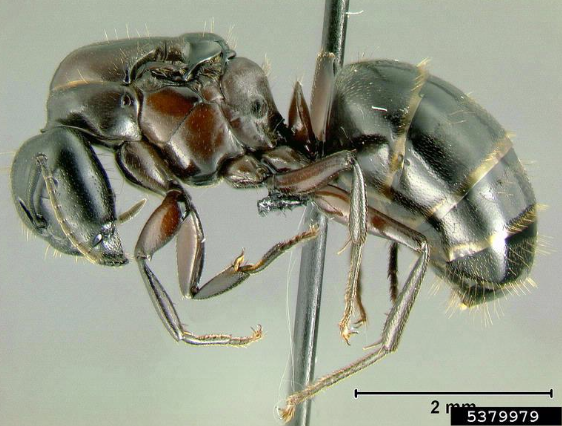
Gary Alpert, Harvard University, Bugwood.org
Tiny piles of sawdust can serve as a sign of infestation by carpenter ants within your home. A good indicator to identify if their nest is inside your home is the presence of large amounts of winged adults indoors. If you are finding wingless female ants, this is not a sure sign the colony is inhabiting your home; they may have entered your home to search for a nesting site, but have not yet colonized wood structures inside.
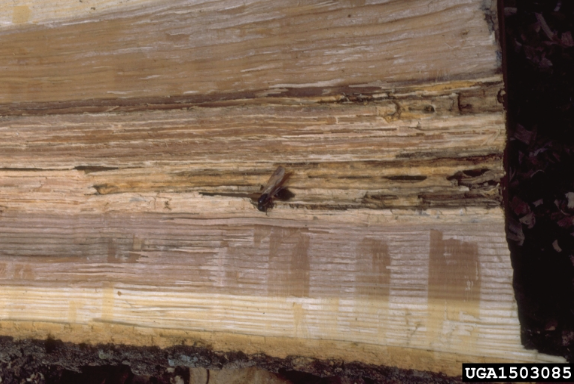
Daniel H. Brown, USDA Forest Service, Bugwood.org
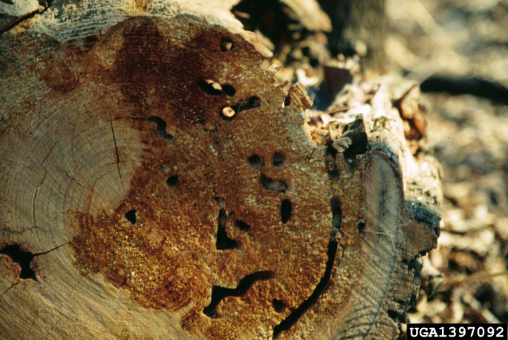
Joseph OBrien, USDA Forest Service, Bugwood.org
Life Cycle
Winged carpenter ants, female reproductives and males, will mate during late May to early June. After mating, the female will look for a nesting site, which is typically in soil or wood. Within a small cavity, the queen will seal the entrance and lay 15-20 eggs. The eggs will hatch into grub-like larvae (white, c-shaped body) and feed on secretions from the queen’s mouth. For the first brood, the queen will take care of the first ants, but once emerged, she will shift responsibilities to workers so she can focus her energy on laying more egg batches. The larvae will complete their development and emerge as wingless worker ants. As the colony grows, the ants seen roaming around your home are the worker ants. Worker ants are in charge of collecting protein and sugar sources, enlarging the nest, and providing nourishment and protection for eggs and larvae. In most colonies, it can require years to begin producing reproductives because many carpenter ant species only possess one egg laying queen within the colony.
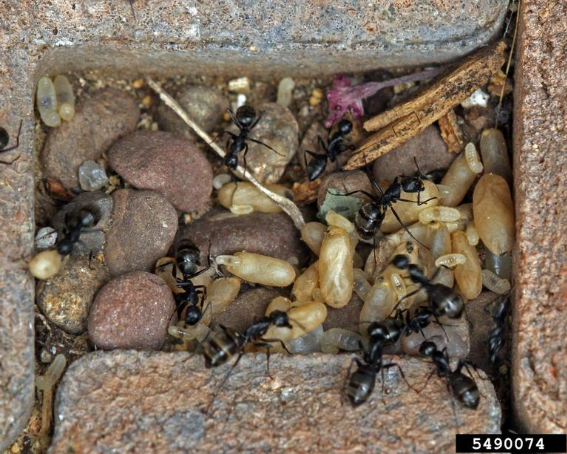
David Cappaeert, Bugwood.org
Workers can be found year round indoors. Swarmers, the winged adults, will only emerge during spring time. Once the swarmers emerge, they will mate and the female reproductive will lose her wings while the male will die. Colony growth stops during the winter time, and resumes when sufficient indoor heat or sunshine is met again. The queen, workers, winged reproductives, and larvae will overwinter in a dormant metabolic state. The ants will remain dormant and inactive until the spring.
Prevention & Control Measures
In order to prevent carpenter ants indoors, it is important to eliminate high moisture and possible entry points from the outdoors. Homes located in woodland habitats serve as prime candidates for carpenter ant infestation because of the tree abundance, landscape timbers, and wooden fences or porches. Sources of high moisture could arise from moisture-damaged wood and low air circulation. Leaky pipes, damaged roofing, poorly ventilated attics, and clogged gutters can serve as constant moisture sources that attract the ants to your home. There are many common entry points for carpenter ants to make their way into your home as well. Holes and cracks, earth-to-ground contacts, and overhanging branches near your home may be easy access points for the insects to enter indoors. Any easy access point for ants to come into contact with the building and find an entryway inside should be considered and eliminated when possible.
Once you have identified that your invasion is a result of carpenter ants, you can begin to target and find nests. The most important aspect for carpenter ant pest management is inspection and finding the nest and foraging trails. Homeowners should track where ants seem to continuously return back to, this location is likely an indication of the vicinity of their nest. You may place droplets of honey or jelly to attract ants so you can easily follow them back to their colony.
Once the nest is located, residual insecticides may be applied to treat the infestation. These insecticides may be liquid or dust, and must be applied to the nest in order to be effective for elimination. Holes may be drilled into the wood in order to directly reach the nest; this step may be left to the professionals due to the danger of damaging the integrity of the home's structure. The most effective insecticide controls include sprays containing pyrethroids, dusts containing borates, and desiccant dusts. Baits can be used to help locate and eliminate the colony. Baits are a food source that includes a combination of food and a pesticide. This tool can help to spread the poison throughout the colony and potentially reduce the total population or eliminate the nest. To increase your chances for success, you should monitor the baits and replace them when consumed or not being consumed. Toxic baits should contain slow-acting formulations to increase the likelihood of the ant carrying and sharing the insecticide with the rest of the colony. Yellow granular baits are also useful because the product is easily seen as ants carry it back to their nest. Replacing moist and damaged wood is also a good idea to exclude home infestations. To prevent re-infestations you should eliminate sources of moisture and cracks or crevices that insects can get through from outdoors.
Outdoor infestations are important to be aware of because outdoor colonies can get inside your home if there is easy access. If you are seeing an outdoor infestation, it is important to reduce access to your home to prevent the ants from getting indoors. Some control measures may include: sealing off potential entry points such as cracks and crevices, reducing mulch around home to discourage nesting, eliminating wood decay, and pruning of overgrown trees. Pest management professionals should be contacted if outdoor control is necessary.
Due to the nature of the carpenter ants’ tunnels, the interior of their nests can be quite difficult to identify, and it is recommended to seek professional help. Pest management professionals should be contacted to conduct control measures with equipment and insecticides that they are trained to use and apply. Fipronil sprays are very effective against carpenter ant infestations, but should only be applied by licensed applicators.
References
Hahn, J., & Kells, S. (2020). Carpenter ants. Retrieved from https://extension.umn.edu/insects-infest-homes/carpenter-ants
Mallis, A. (1945). Handbook of pest control. Richfield, OH: GIE Media, Inc.
Pellitteri, P. J. (2003). Controlling carpenter ants. Retrieved from https://hort.extension.wisc.edu/articles/controlling-carpenter-ants/
University of California Agriculture & Natural Resources. (2009). Carpenter ants. Retrieved from https://ipm.ucanr.edu/PMG/PESTNOTES/pn7416.html
Issued: 2/93
Revised: 11/24
CAUTION! Pesticide recommendations in this publication are registered for use in Kentucky, USA ONLY! The use of some products may not be legal in your state or country. Please check with your local county agent or regulatory official before using any pesticide mentioned in this publication.
Of course, ALWAYS READ AND FOLLOW LABEL DIRECTIONS FOR SAFE USE OF ANY PESTICIDE!
Images: university of Kentucky unless otherwise attributed.
